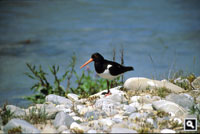
Fauna
The Strath Taieri hosts birds typical of dry inland shrublands and open farm country. The most striking species are two daytime birds of prey, the Australasian harrier hawk/kahu, which is often seen scavenging road kill, and the smaller, faster and rarer New Zealand falcon/karearea, which takes only live prey.
Commonly seen on farmland or wettish areas are the paradise shelduck/putakitaki, white-faced heron/matuku moana, pied oystercatcher/torea, Australian magpie and a range of introduced finches, including greenfinch, goldfinch, chaffinch and yellow hammer.
Numerous lizard species live in the schist landscape, including the common skink, green skink and, rarely now, the endangered Otago skink.
Among the insects, the largest is the mountain weta Hemideina maori, a flightless cricket up to 65 mm long, which lives on the summit areas of the Rock and Pillar Range.
New Zealand falcon, karearea
A spectacular, lightning fast bird of prey, this uncommon creature frequents the Taieri Gorge and hills above the Strath Taieri. It is smaller than the more common Australian Harrier but no less territorial.
- Karearea, the New Zealand falcon
- Peat, N. (1992). The Falcon and the Lark – A New Zealand High Country Journal. John McIndoe: Dunedin.
South Island pied oystercatcher or torea
The South Island pied oystercatcher with its distinctive black and white colouring and red beak is seen throughout the region in summer.
- Bird Forum's wiki on the South Island pied oystercatcher
- Sound recordings of the South Island pied oystercatcher
Otago skink
Otago skinks growing up to 300mm in length and are unique to Otago. It is one of New Zealand's rarest reptiles. It is only found in certain locations in Otago amongst schist rock tors. You will see them "sunning" themselves on rocks to warm up for activity. They have distinctive black, yellow, and green spots, which serves as camouflage in their habitat of lichen-covered rocks and schist outcrops. Like most skinks, Otago skinks are omnivores.
Skinks and geckos are the only 2 native families of lizard. The number of Otago skinks has declined to a point where habitat protection, predator-proof fencing and predator control has become necessary. Some predict they will be extinct in the wild within a few years..
- Skinks and geckos: similarities and differences
- DOC's information page about Grand and Otago skinks (everything from fact files to video)
- Video: Endangered species grand and Otago skinks in New Zealand (5 min)
- Grand and Otago Skink Recovery Plan

- Birth of rare skinks coup for sanctuary (Otago Daily Times, 10 Feb 2011)
Mountain weta
Wetas are a group of about 70 insect species native to New Zealand. Mountain wetas (Hemideina maori) is the smallest of them at 4cm and can survive cold temperatures down to –10°C for a long period of time, even when 82 per cent of their body water is frozen. Special proteins in their blood (haemolymph) prevent ice from forming in their cells.
Wetas are found primarily in cavities under flat rocks on isolated outcrops or tors. They hide during the day and come out to feed at night. Wetas are omnivores and feed on insects and plant material. Palps around the jaws help them taste food before they eat it.
Wetas have ears and hollow tubes in their front legs to hear with.
Males are aggressive with larger heads than females. They will chase away other males but let females into their territory. The female lays eggs in the soil almost all year round, except mid-winter, and can lay as many as 300 eggs in her lifetime.
- The Secret Life of Wetas with insect guy George Gibbs - Audio (Radio Live). A fascinating account of wetas!.

Photo by www.arcphoto.co.nz

Photo by Bruce McLennan

Photo by www.arcphoto.co.nz


Photo by Bruce McLennan

Photo by Neville Peat